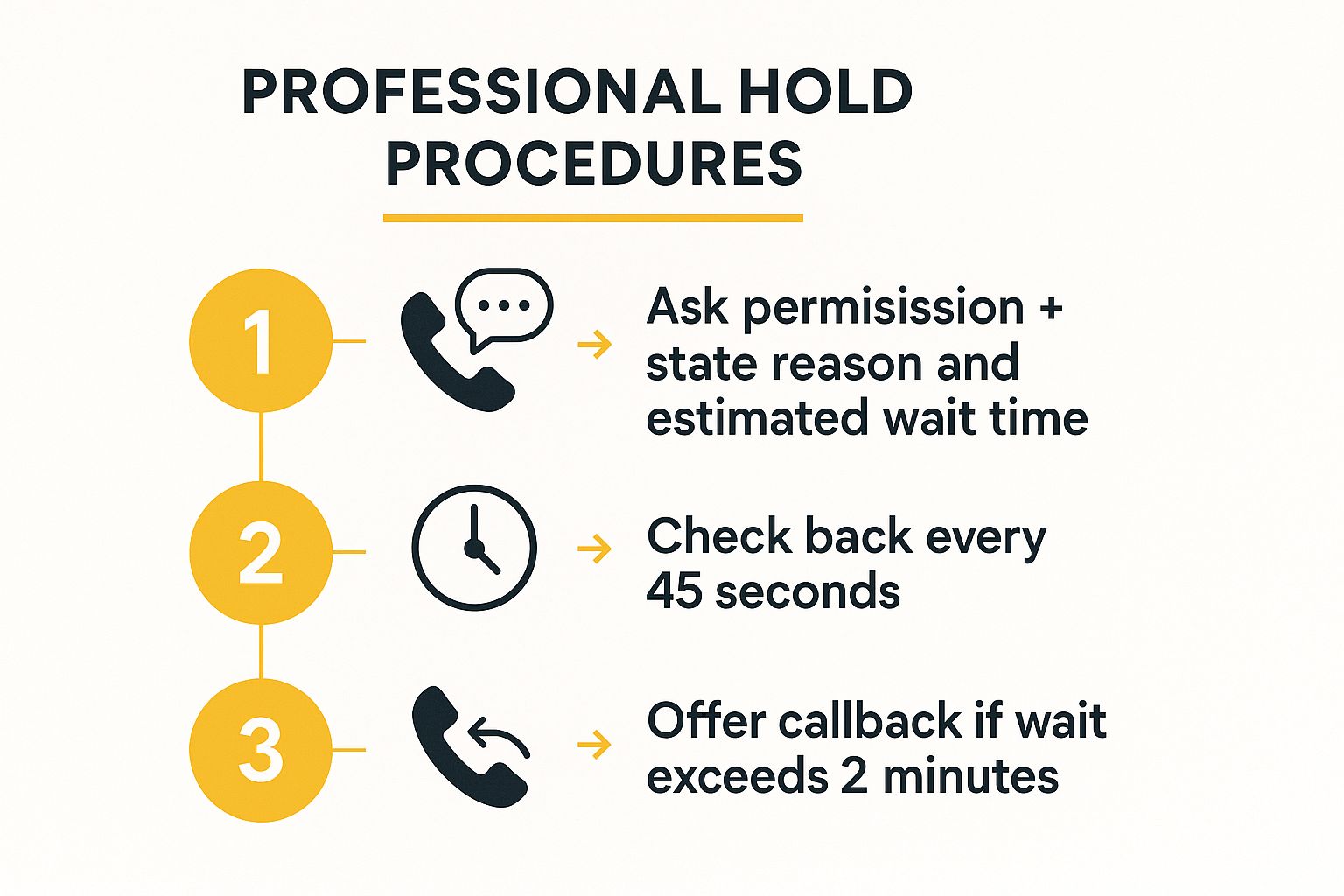Why Mastering Phone Etiquette Still Matters in a Digital-First World
In an era dominated by emails, instant messages, and video conferences, the humble phone call remains a powerful tool for building rapport and resolving complex issues. However, its effectiveness hinges on one critical factor: professional phone etiquette. Poor call handling can damage client relationships, create internal friction, and project an image of disorganisation. For professionals like mortgage brokers, real estate agents, and small business owners, where every interaction counts, these missteps can directly impact the bottom line.
Conversely, mastering the nuances of phone etiquette in the workplace can set you and your organisation apart, turning every call into an opportunity to strengthen connections and demonstrate competence. This is not about outdated rules, but about building a reputation for reliability and professionalism that resonates with clients and colleagues alike.
This guide moves beyond the basics to explore seven essential best practices. We will provide actionable strategies to transform your phone communication from a routine task into a strategic asset. We'll also highlight how modern tools like OnSilent can help streamline these practices, ensuring you never miss a critical call while maintaining peak productivity and delivering exceptional service. Get ready to refine your approach and make every call count.
1. Always Answer Within 3 Rings
The three-ring rule is a cornerstone of professional phone etiquette in the workplace. It dictates that you should answer an incoming call before it rings a fourth time. With each ring lasting approximately six seconds, this gives you a window of about 18 seconds to respond. This timeframe is the sweet spot; it’s long enough for you to shift focus from your current task and prepare for the call, but short enough to show the caller that their communication is valued and that your business is responsive. Failing to answer promptly can create an impression of disorganisation or, worse, that the caller's business is not a priority.
This principle isn’t just theoretical; it’s a proven strategy for success across various industries. Consider Zappos, the online shoe retailer famous for its legendary customer service. Its representatives are trained to pick up within three rings to create an immediate, positive connection. Similarly, medical offices adhere to this rule to ensure patient concerns are handled with urgency and care. For real estate agents and mortgage brokers, a quick response can be the deciding factor in capturing a valuable lead before they call a competitor.
How to Implement the Three-Ring Rule
Adhering to this rule requires a proactive setup, especially for busy professionals who aren't always at their desks. Here are some practical tips:
- Prepare Your Greeting: Have a polished, professional greeting ready to go. Something simple like, "Good morning, [Your Company], this is [Your Name] speaking," ensures you sound composed, even when answering in a hurry.
- Use the Right Tools: A headset is invaluable, allowing you to answer calls hands-free while accessing files on your computer or taking notes. This simple tool dramatically improves your ability to respond quickly and efficiently.
- Forward Your Calls: If you frequently step away from your desk, set up call forwarding to your mobile device. This ensures you remain reachable and can maintain the three-ring standard wherever you are in the office. Many modern phone systems, including virtual reception services, can automate this process and help you reduce missed calls and uphold professional standards.
- Be Ready for Action: Keep a notepad and pen or a digital note-taking app open and accessible at all times. Being prepared to jot down important details from the moment you answer demonstrates exceptional organisation and respect for the caller's time.
2. Use a Professional Greeting Formula
A professional greeting formula provides essential structure and consistency to every business call, acting as the verbal equivalent of a firm handshake. The standard format includes four key elements: a polite greeting (like "Good morning" or "Good afternoon"), your company's name, your personal name, and a clear offer to help. This formula ensures all crucial information is communicated upfront, immediately setting a professional and efficient tone. It reassures callers they have reached the correct place and person, eliminating confusion and starting the interaction on a positive, organised note.

This principle of standardised excellence is a hallmark of world-class customer service, popularised by organisations like Dale Carnegie and the Disney Institute. Consider The Ritz-Carlton, where staff are trained to use a precise, warm greeting that often includes the guest's name if known, creating an immediate sense of recognition and importance. Similarly, Bank of America trains its tellers to use a consistent greeting across all branches, reinforcing brand reliability. For a small business, such as a local law firm or a trades professional, adopting a polished greeting formula is a powerful way to project the same level of professionalism as a larger competitor, building trust from the first second of the call.
How to Implement a Professional Greeting Formula
Developing a consistent greeting requires practice until it becomes second nature. It's a fundamental aspect of phone etiquette in the workplace that signals competence and respect. Here are practical tips to perfect your opening:
- Practise Your Script: Write down your ideal greeting and say it out loud until it sounds natural, not robotic. A great example is, "Good morning, [Your Company], you're speaking with [Your Name]. How can I help you today?"
- Smile While You Speak: It may feel strange, but smiling physically alters the tone of your voice, making it sound warmer, more approachable, and more positive to the person on the other end of the line.
- Keep it Concise: Your entire greeting should take less than 10 seconds. This is long enough to convey all necessary information without wasting the caller's time, showing you value efficiency.
- Adjust Your Energy: Match your vocal energy to the time of day. A bright "Good morning!" can be energising, while a calmer "Good afternoon" might be more appropriate later in the day.
3. Master the Art of Professional Hold Procedures
Placing a caller on hold is sometimes unavoidable, but how you manage it is a critical test of your professional phone etiquette in the workplace. Professional hold procedures are about more than just pressing a button; they involve a structured approach to ensure the caller feels respected, informed, and valued, even while they wait. This practice transforms a potential point of frustration into an opportunity to demonstrate your organisation’s commitment to excellent service. Leaving a caller in silence can make them feel abandoned and unimportant, risking the loss of valuable business.
This principle is expertly applied by leading companies across various sectors. Apple's customer support, for instance, often offers a scheduled callback rather than subjecting customers to prolonged hold times, showing immense respect for their time. In the high-stakes healthcare industry, receptionists use meticulous hold procedures to consult with doctors or access patient files while upholding strict privacy standards. Similarly, for trades professionals or real estate agents, managing holds effectively while retrieving job details or property information can reinforce a client’s confidence in their competence and organisation.
The infographic below illustrates the three essential steps to follow for a professional and courteous hold experience.

This simple process flow demonstrates that maintaining communication is the key to transforming a necessary wait into a positive customer interaction.
How to Implement Professional Hold Procedures
Mastering hold procedures requires a combination of clear communication and proactive time management. Here are some actionable tips to ensure your callers never feel forgotten:
- Always Ask for Permission: Before placing someone on hold, politely ask for their consent. A simple, "May I place you on a brief hold while I retrieve that information?" and waiting for their "yes" shows respect for their time and control over the conversation.
- Explain and Estimate: Briefly tell the caller why you need to put them on hold and give them a realistic estimate of the wait time. For example, "It will take me about 60 seconds to pull up your account details." This manages expectations and reduces their perceived wait time.
- Check Back Regularly: If the hold will be longer than a minute, set a timer to remind yourself to check back with the caller every 45 to 60 seconds. A quick update like, "Thank you for your patience, I'm still working on this for you," reassures them they haven’t been disconnected or forgotten.
- Offer Alternatives: For waits expected to exceed two minutes, offer a more convenient alternative. Saying, "This is taking longer than I anticipated. Would you prefer to continue holding, or may I call you back with the information?" empowers the caller and demonstrates excellent service. This is a core component of advanced call handling best practices.
- Thank Them for Their Patience: When you return to the line, always thank the caller for holding. This small courtesy acknowledges their cooperation and ends the hold period on a positive, appreciative note.
4. Practice Active Listening and Verbal Confirmation
Active listening is a fundamental skill in professional phone etiquette in the workplace, yet it is often overlooked. It involves concentrating fully on what the other person is saying, rather than just passively hearing the words they use. Since you lack the visual cues of face-to-face interaction, you must rely on verbal acknowledgements and paraphrasing to build rapport and ensure total clarity. This technique is crucial for preventing misunderstandings, showing respect, and making callers feel genuinely heard and valued, which solidifies trust and strengthens business relationships.

This principle, popularised by communication experts like Stephen Covey and Dale Carnegie, is a game-changer in client-centric industries. For instance, Nordstrom’s customer service representatives use active listening to grasp a client's fashion preferences, allowing them to suggest perfect alternatives when an item is unavailable. Similarly, tech support teams at companies like Microsoft paraphrase complex technical problems to confirm they have the details right before attempting a solution. For financial advisors and mortgage brokers, it’s an indispensable tool for understanding a client's risk tolerance and long-term financial goals, ensuring their advice is perfectly aligned.
How to Implement Active Listening
Mastering active listening over the phone requires conscious effort and specific techniques. Here are some actionable tips to integrate this powerful skill into your calls:
- Paraphrase and Summarise: Before moving on or offering a solution, repeat the caller's key points back to them. Use phrases like, "So, if I am understanding correctly, you're looking for…" or "Let me just confirm the main issue is…" This confirms you've understood and gives them a chance to correct you.
- Provide Verbal Cues: Since the caller can't see you nodding, use small verbal cues to show you are engaged. Simple affirmations like "I see," "mm-hmm," or "that makes sense" are incredibly effective at reassuring the speaker that you are following along without interrupting their flow.
- Ask Clarifying Questions: Don't be afraid to ask for more detail. Questions like, "Could you elaborate on that point?" or "When you say it's urgent, what is your ideal timeline?" demonstrate deep engagement and a commitment to getting things right the first time.
- Take Detailed Notes: Keep a pen and notepad or a digital document handy. Jotting down key names, dates, and action items not only helps you stay focused but also ensures you capture critical information accurately, demonstrating professionalism and attention to detail.
5. Implement Proper Call Transfer Protocols
A poorly handled call transfer is one of the quickest ways to frustrate a client and damage your professional reputation. Proper call transfer protocols are a vital component of phone etiquette in the workplace, ensuring a seamless and positive experience as a caller is passed from one person or department to another. This process involves more than just pressing a button; it's a "warm handoff" that maintains the continuity of the conversation, prevents the caller from having to repeat themselves, and demonstrates organisational competence. A smooth transfer shows the caller that your team is coordinated and values their time.
This principle is expertly demonstrated by large-scale operations where customer experience is paramount. Amazon’s customer service, for instance, excels at warm transfers, where the initial agent briefs the next specialist on the customer's issue before connecting them. In healthcare, hospitals use strict transfer protocols to ensure critical patient information is accurately relayed between departments, safeguarding patient care. Similarly, telecommunication companies like Optus or Telstra have refined procedures for technical support escalations, ensuring the issue's history travels with the call, so the customer doesn't have to start from scratch with each new technician.
How to Implement Proper Call Transfer Protocols
Mastering the art of the warm transfer requires a clear process and a focus on communication. Here are some actionable tips to ensure your transfers are professional and effective:
- Explain and Ask Permission: Always inform the caller why a transfer is necessary and who they will be speaking to. For example, say, "John in our accounts team is the best person to help with that. May I transfer you to him?" This simple step gives the caller control and sets clear expectations.
- Brief the Receiving Colleague: Before completing the transfer, provide your colleague with a concise summary of the caller's needs. This is the core of a warm transfer and is the most critical step in preventing client frustration. A quick, "I'm transferring Sarah, she needs to discuss the invoice from last Tuesday," is all it takes.
- Confirm the Connection: Don't just transfer and disconnect. Stay on the line briefly to introduce the caller to your colleague and ensure they have successfully connected and that the other party is ready to assist. For example, "John, I have Sarah on the line for you regarding an invoice query. Sarah, John is here to help."
- Provide a Fallback Option: In case the transfer fails or the call disconnects, offer your direct number or name as a point of contact. This provides a safety net for the caller and shows that you are personally invested in a successful resolution, reinforcing a high standard of professional phone etiquette in the workplace.
6. Maintain Professional Tone and Language
Your voice and language over the phone are a direct reflection of your company's brand and professionalism. Maintaining a professional tone involves more than just being polite; it’s about using appropriate vocabulary, speaking with a courteous demeanor, and adapting your communication style to the specific business context. This means avoiding slang, speaking clearly at a measured pace, and using positive, encouraging language to build rapport and trust with every caller, from a potential client to a long-term supplier.
This principle is a core component of phone etiquette in the workplace and is championed by organisations known for exceptional service. Consider the Four Seasons hotel chain, where staff are trained to use warm, welcoming language that mirrors their luxury service standards. Similarly, customer service representatives at technology companies like IBM must use precise technical language while ensuring they remain accessible and understandable to non-technical clients. In these environments, your tone isn’t just a detail; it’s the primary tool for conveying competence and care.
How to Maintain a Professional Tone
Mastering your vocal presence requires conscious effort and practice. Here are several actionable tips to ensure you always sound polished and professional:
- Pace Your Speech: Aim to speak about 10-15% slower than your normal conversational pace. This makes you easier to understand and projects an image of calm and control, which is especially important when dealing with complex or urgent matters.
- Use Positive Phrasing: Swap out negative or indifferent phrases for positive, proactive alternatives. Instead of "No problem," try a more engaging "I'd be happy to help with that." This simple change shifts the dynamic from passive to actively helpful.
- Practise Difficult Words: Before a call, take a moment to practise pronouncing difficult names, technical terms, or industry jargon. This small preparation prevents fumbling and shows respect for the caller and the subject matter.
- Record and Review: Use your phone's voice recorder to listen back to your side of a conversation. This self-assessment is invaluable for identifying areas for improvement, such as overuse of filler words like "um" or "like." For a more structured approach, specialised phone etiquette training can provide targeted feedback and guidance to refine your communication skills.
7. Manage Personal Phone Use Boundaries
Establishing clear boundaries for personal phone use is a critical component of professional phone etiquette in the workplace. This involves understanding and adhering to guidelines on when and how personal calls and device usage are appropriate during work hours. The goal is to ensure personal matters do not disrupt productivity, compromise customer service, or create a perception of unprofessionalism. Ignoring these boundaries can lead to missed deadlines, poor quality work, and strained relationships with both colleagues and clients.
This principle is vital across all industries, particularly those requiring high levels of focus and client interaction. For instance, a mortgage broker who is constantly checking their personal phone during a client meeting sends a clear message that the client is not their top priority. In healthcare facilities, strict policies are enforced not only for productivity but also to protect patient privacy and confidentiality. Even in more relaxed environments like a tech company, such as Google, there are still expectations; employees might take personal calls during breaks, but are often required to step away from open-plan work areas to avoid disturbing others.
How to Implement Personal Phone Boundaries
Effectively managing your personal phone requires self-discipline and respect for your professional environment. Here are some practical ways to maintain these crucial boundaries:
- Utilise Designated Break Times: Schedule your personal calls and extensive messaging for your official lunch or tea breaks. This respects your employer’s time and ensures you are fully focused on your tasks during work periods. This is a simple yet powerful way to demonstrate your commitment.
- Find a Private Area: When you do need to take an important personal call, step away from your desk, client-facing areas, and colleagues. Find a private space like a break room, an empty office, or an outdoor area to maintain confidentiality and avoid disrupting the workplace.
- Keep It Brief and Infrequent: Keep necessary personal calls as short and to the point as possible. A quick call to confirm an appointment is acceptable; a lengthy chat with a friend is not. Limiting the frequency of these calls reinforces your professional focus.
- Set Your Phone to Silent: One of the most important aspects of phone etiquette in the workplace is minimising distractions. Set your personal device to silent or vibrate mode and keep it out of sight. This prevents constant notifications from pulling your attention away from important tasks and client interactions.
7 Key Phone Etiquette Practices Comparison
| Item | Implementation Complexity 🔄 | Resource Requirements 🔄 | Expected Outcomes 📊 | Ideal Use Cases 💡 | Key Advantages ⭐ |
|---|---|---|---|---|---|
| Always Answer Within 3 Rings | Moderate – requires quick response | Moderate – may interrupt tasks | High – reduces missed calls, creates positive first impression 📊 | Customer service, lead capture, professional offices | Enhances professionalism, reduces hang-ups ⭐ |
| Use a Professional Greeting Formula | Low – standardized script | Low – training to maintain quality | Moderate – consistent brand experience | All business calls, customer-facing roles | Builds credibility, clear company ID ⭐ |
| Master the Art of Professional Hold Procedures | Moderate – requires precise timing and communication | Moderate – staff attention and training | High – lowers hang-ups, improves satisfaction 📊 | Call centers, healthcare, peak call periods | Demonstrates respect, reduces frustration ⭐ |
| Practice Active Listening and Verbal Confirmation | High – requires focused attention and skill | Moderate – training and note-taking tools | Very High – improves rapport, reduces errors 📊 | Technical support, financial advising, retail | Strengthens relationships, increases resolution rates ⭐ |
| Implement Proper Call Transfer Protocols | Moderate to High – coordination needed | Moderate – staff cooperation and follow-up | High – ensures smooth handoffs, customer satisfaction 📊 | Multi-department support, healthcare, telecom | Maintains continuity, reduces customer effort ⭐ |
| Maintain Professional Tone and Language | Low to Moderate – training & practice | Low – ongoing coaching and self-monitoring | Moderate – improves call quality and brand perception 📊 | All phone interactions, customer service | Builds trust, creates pleasant experience ⭐ |
| Manage Personal Phone Use Boundaries | Low – policy enforcement | Low – clear guidelines and monitoring | Moderate – maintains productivity and professionalism 📊 | Workplaces with customer interaction or strict policies | Prevents distractions, preserves work standards ⭐ |
Transforming Your Calls into Connections
Mastering phone etiquette in the workplace is not merely about adhering to a rigid set of rules; it's a strategic art form that transforms routine calls into meaningful business connections. Throughout this guide, we've explored the foundational pillars of professional communication, from the simple yet powerful act of answering within three rings to the nuanced skill of maintaining a professional tone, even during challenging conversations. Each principle serves a distinct purpose, yet they all converge on a single, powerful outcome: building trust, fostering respect, and solidifying your professional reputation with every single interaction.
Implementing these practices consistently is what separates good professionals from great ones. Think of each call as an opportunity to reinforce your brand, whether you're a real estate agent finalising a deal, a mortgage broker reassuring a client, or a trades professional coordinating a complex job. A polished greeting, effective hold procedures, and active listening are not just niceties; they are tangible demonstrations of your competence and respect for the other person's time. By dedicating focus to these areas, you are actively investing in the long-term health of your client relationships and your business.
From Principles to Practice: Your Actionable Roadmap
The journey to exceptional phone communication begins with small, deliberate steps. Don't feel overwhelmed by the need to perfect everything at once. Instead, choose one or two areas to focus on this week.
- This Week's Challenge: Concentrate on your professional greeting formula and your active listening skills. Before answering each call, take a deep breath. Greet the caller with the clear, professional structure we outlined. During the conversation, make a conscious effort to paraphrase their key points to ensure you've understood them correctly.
- Next Week's Goal: Shift your focus to call transfer protocols and managing personal phone use. Audit your current transfer process. Is it seamless, or does it create friction for the caller? Simultaneously, establish clear boundaries for your personal device, committing to keeping it silent and out of sight during meetings and client interactions.
This incremental approach makes improvement manageable and sustainable, turning best practices into ingrained habits. The true value of excellent phone etiquette in the workplace emerges when these actions become second nature, allowing you to build rapport effortlessly and navigate any conversation with confidence and professionalism. It’s about ensuring your phone remains a powerful tool for business growth, not a source of frustration or missed opportunities.
Ready to elevate your phone communications and eliminate the distractions that undermine your professionalism? Discover how OnSilent can intelligently filter spam, prioritise important callers, and help you implement these etiquette principles with ease. Take control of your calls and start building stronger connections today.

